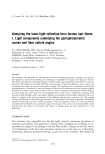278 JOURNAL OF COSMETIC SCIENCE Table I AFM Section Analysis Roughness (nm) Surface distance (•m) Thickness (nm) Unexposed Exposed U nexposed Exposed Unexposed Exposed 4.30 13.5 26.596 24.999 406.61 267.18 4.40 8.84 26.465 25.076 450.45 249.68 6.14 18.8 26.300 25.044 548.88 349.18 5.65 15.46 26.460 25.027 490.06 249.02 4.61 18.4 26.746 25.342 392.94 252.36 6.30 15.68 26.507 25.609 465.75 241.08 6.10 21.45 26.393 25.290 364.40 203.84 5.60 23.6 26.544 25.395 308.19 398.58 4.82 24.7 26.869 25.454 436.78 434.15 6.11 14.67 26.488 25.528 402.05 391.10 4.46 10.36 26.250 25.308 425.60 292.77 5.33* 16.86' 26.51' 25.28* 426.52* 302.63* 0.78** 5.1 ** 0.18** 0.21'* 64.2** 77.20** p 0.0001 p 0.0001 p = 0.0006 * Mean. ** Standard deviation. data presented in Table I were again analyzed statistically by the same procedure. These observations demonstrated and proved quantitatively that long-term UV irradiation causes thinning and fusion of the surface cuticle cell. Second, as shown in Figures 6a and 6b, another parameter used to evaluate thinning was cuticle thickness. The cuticle thickness values were evaluated by measuring the maxi- mum peak distance in each cross section presented in Figures 6a and 6b. The results of this evaluation showed lower values for UV-exposed hair, as indicated in Table I. These findings ratify the observation verified in the surface distance parameter, confirming that long-term exposure to UV radiation results in a decrease in the surface modulus. This observation is consistent with the destruction of the cuticle structure due to the dete- rioration caused by protein (cistine) degradation, which leads to the decrease in cuticle thickness. The surface distance test, developed by our team members, was proven to be able to separate hair samples into unexposed and degraded populations. The Student t-test, as already mentioned, was applied to the data and supported such a separation. The average value of surface distance for the unexposed hair was 26.51 pm against 25.28 pm for the damaged hair (see Table I). The Student t-test was also applied to the results of roughness and thickness, obtaining the same result in discriminating unexposed and exposed hair. The average value of roughness was 5.33 nm for the unexposed hair, increasing to 16.86 nm for the exposed hair. As for the thickness test, the average value of the unexposed hair was 426.52 nm, decreasing to 302.63 nm for the exposed hair. CONCLUSIONS In this study, we presented a new methodology for evaluating morphological changes in human hair. We believe that this technique is superior to any other available, combining
EVALUATION OF UV HAIR DAMAGE BY AFM 279 C) •o..• , 0 10'.0 •-0'. 0 Min , 0 10",0 •-0.0 Figure 5. AFM: surface distance analysis. (a) Control: virgin hair (0 hours). (b) Exposed (160 hours) to UV radiation.
Purchased for the exclusive use of nofirst nolast (unknown) From: SCC Media Library & Resource Center (library.scconline.org)






























































































